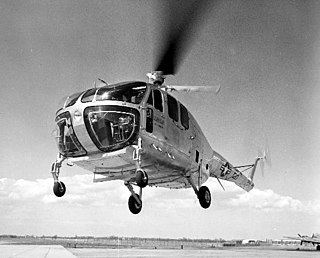Related Research Articles

The Yakovlev Yak-12 is a light multirole STOL aircraft used by the Soviet Air Force, Soviet civilian aviation and other countries from 1947 onwards.

The Yakovlev Yak-24 is a Soviet twin-engine, tandem rotor, transport helicopter developed by Yakovlev in the 1950s. The Yak-24 saw limited use in the Soviet Air Force, and the exact number produced and duration of service are unknown due to inconsistencies in data.

The Mil Mi-1 was a Soviet three- or four-seat light utility helicopter. It was the first Soviet helicopter to enter serial production. It is powered by one 575 hp Ivchenko AI-26V radial. It entered service in 1950 and was first seen on the 1951 Soviet Aviation Day, Tushino and was produced for 16 years. More than 1,000 were built in the USSR and 1,594 in Poland, as SM-1.

The Kamov Ka-15 was a Soviet two-seat utility helicopter with coaxial rotors, which first flew on 14 April 1952 at the hands of test pilot D. K. Yefremov. It was the world's first mass-produced coaxial helicopter. State acceptance trials were completed in 1955, and the helicopter entered production the following year at aircraft factory No. 99 in Ulan-Ude. It was a precursor to the Ka-18 and was fitted with the M-14 engine. It was primarily used for bush patrol, agricultural purposes and fishery control.

The Kamov Ka-10 was a Soviet single-seat observation helicopter that first flew in 1949.

The Ivchenko AI-14 is a nine-cylinder, air-cooled, radial piston engine designed in the Soviet Union to power aircraft.

The Bell R-12 was an American 1940s military utility helicopter built by the Bell Helicopter company.

The Bratukhin Omega was an early Soviet helicopter, the first product of a new Soviet design bureau, OKB-3 that was created from within TsAGI specifically to develop rotary-wing aircraft. Bratukhin's design was a side-by-side twin rotor machine, with each rotor carried on a long outrigger truss. The Omega's rotors were each powered by a separate engine carried in a nacelle also at the end of the truss. Captive trials commenced in August 1941 and revealed severe problems with engine vibration and overheating. Before these could be addressed, however, OKB-3 was evacuated ahead of the German advance into the Soviet Union.
Bratukhin, or OKB-3, was a Soviet aircraft design bureau created in 1940 from within TsAGI to develop helicopters. Headed by Ivan Pavlovich Bratukhin, the bureau built several experimental helicopters over the next decade. Each model had the same basic design of two rotors with separate engines carried on the ends of outriggers to each side of the fuselage. The bureau was dissolved in 1951.

The Keystone LB-6 and LB-7 were 1920s American light bombers, built by the Keystone Aircraft company for the United States Army Air Corps, called Panther by the company, but adoption of the name was rejected by the U.S. Army.

The Fokker F-14 was an American seven/nine passenger transport aircraft designed by Fokker and built by their Atlantic Aircraft factory in New Jersey.

The PZL SM-2 was a Polish light utility helicopter, enlarged version of license-built Mil Mi-1, developed and produced by WSK PZL-Świdnik. It was also known as the WSK SM-2.

The Yakovlev Yak-100 was a single-engine, transport helicopter developed in the USSR in 1948. This was the Yakovlev Design Bureau's second helicopter.
The Beriev MDR-5 (sometimes Beriev MS-5) was a Soviet long-range reconnaissance/bomber flying boat prototype developed by the Beriev design bureau at Taganrog. It did not enter production as the rival Chyetverikov MDR-6 was preferred.

The Bratukhin B-11 was a prototype Soviet twin-rotor transport helicopter and the last design of the Bratukhin aircraft design bureau to be built.
The Yatsenko I-28 was a 1930s Soviet single-seat fighter designed by Vladmir Yatsenko and first flown in 1939. The I-28 was a low-wing cantilever monoplane of mixed construction powered by a 900 hp (671 kW) Tumansky M-87 radial piston engine. It had an enclosed single-seat cockpit with a rearwards sliding canopy. The wing had an inverted-gull shape to reduce the length of the retractable main landing legs. The prototype was destroyed shortly after the first flight but an order was placed for 30 production aircraft. Also ordered was a prototype of an attack version, the I-28Sh. Although the first five production aircraft were completed the programme was cancelled in early 1940.

The Yakovlev AIR-1 (VVA-3) was a 1920s Soviet two-seat light biplane, the first aircraft designed and built by Aleksandr Sergeyevich Yakovlev.
The Yakovlev Yak-10 was a Soviet light liaison aircraft designed and built by the Yakovlev design bureau in the 1940s.

The Yakovlev AIR-5 was a prototype Soviet single-engined cabin monoplane designed by the Yakovlev design bureau. The AIR-5 was a high-wing strut-braced monoplane with a 200 hp (149 kW) Wright J-4 Whirlwind engine. It had a tubular steel fuselage, wooden wings and an enclosed cabin for a pilot and three passengers.
The Polikarpov Ivanov was a 1930s prototype Soviet ground attack monoplane designed by Polikarpov for a soviet government procurement competition codenamed Ivanov.
References
Notes
Bibliography
- Gunston, Bill (1995). The Osprey Encyclopedia of Russian Aircraft from 1875 - 1995. London: Osprey Aerospace. ISBN 1-85532-405-9.
- Nemecek, Vaclav (1986). The History of Soviet Aircraft from 1918. London: Willow Books. ISBN 0-00-218033-2.
- The Illustrated Encyclopedia of Aircraft (Part Work 1982-1985). Orbis Publishing.